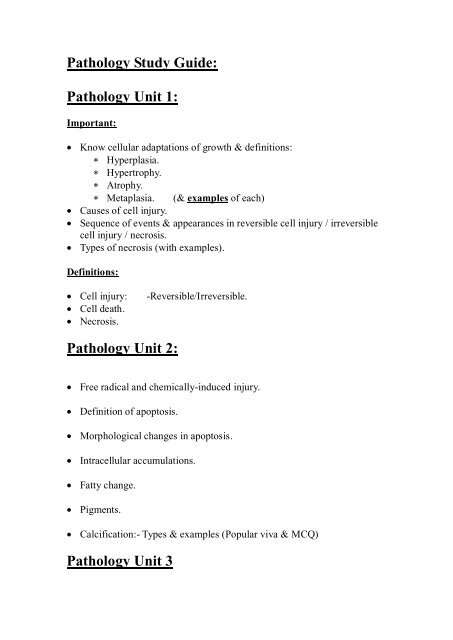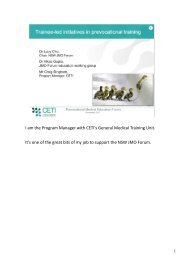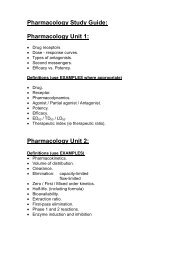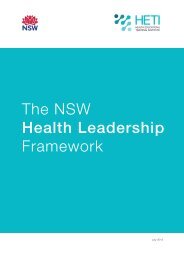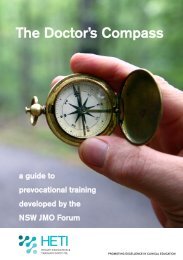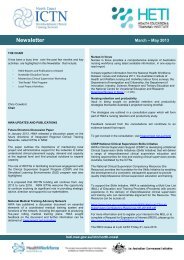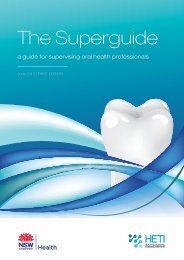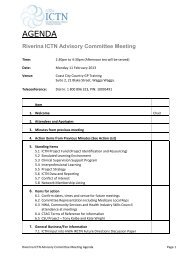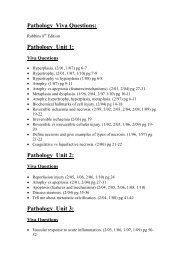Pathology Study Guide: Pathology Unit 1: Pathology Unit 2 ... - HETI
Pathology Study Guide: Pathology Unit 1: Pathology Unit 2 ... - HETI
Pathology Study Guide: Pathology Unit 1: Pathology Unit 2 ... - HETI
- No tags were found...
Create successful ePaper yourself
Turn your PDF publications into a flip-book with our unique Google optimized e-Paper software.
<strong>Pathology</strong> <strong>Study</strong> <strong>Guide</strong>:<strong>Pathology</strong> <strong>Unit</strong> 1:Important:Know cellular adaptations of growth & definitions: Hyperplasia. Hypertrophy. Atrophy. Metaplasia. (& examples of each)Causes of cell injury.Sequence of events & appearances in reversible cell injury / irreversiblecell injury / necrosis.Types of necrosis (with examples).Definitions: Cell injury: -Reversible/Irreversible. Cell death. Necrosis.<strong>Pathology</strong> <strong>Unit</strong> 2:Free radical and chemically-induced injury.Definition of apoptosis.Morphological changes in apoptosis.Intracellular accumulations.Fatty change.Pigments.Calcification:- Types & examples (Popular viva & MCQ)<strong>Pathology</strong> <strong>Unit</strong> 3
Acute inflammation:Components / Sequence of events.Mechanisms.Chemical mediators (need to read histamine, serotonin, complement,kinins, clotting system & PAF.)Cytokines: Definitions, general properties and functional classes; IL-1and TNF. Look at figure 2-21 Tables 2-5 & 2-6 are important.<strong>Pathology</strong> <strong>Unit</strong> 4:Outcomes of acute inflammationChronic inflammation-definition / examples.-histologic features.-macrophages and the mononuclear phagocyte system.-Table 2-7 as an MCQ or a viva question.-other cell types in chronic inflammation.Morphologic features of chronic inflammation.Granulomatous inflammation (TB as a popular example).Systemic effects of inflammation.<strong>Pathology</strong> <strong>Unit</strong> 5:Overview of cell cycle (events during each phase could be an MCQ).Three populations of cells (with examples).Regulation of cell division / Growth inhibition / Growth factorCollagen: Characteristics of different types (Table 3-2) could be an MCQ.
Other constituents of extra cellular matrixRepair / Healing is a lot more important: Figure 3-19 = MCQ. Table 3-4 = MCQ. Wound healing by primary / secondary intention. Factors influencing healing. Complications of wound healing. Fibrosis.<strong>Pathology</strong> <strong>Unit</strong> 6:Revision Week<strong>Pathology</strong> <strong>Unit</strong> 7: Oedema: Definition, types (Table 4-1). Haemostatic process: -Sequence of events-Components:-1 o haemostasis.-2 o haemostasis.-Coagulation pathways. Thrombosis: -Definition.-Pathogenesis.-Predisposing conditions (Table 4-2)-Potential outcomes of thrombosis. Embolism –Definition, types (& examples). Infarction –Definition, types. Shock -Definition.-Types Cardiogenic Hypovolaemic Septic-Stages, particularly features of irreversible shock<strong>Pathology</strong> <strong>Unit</strong> 8:Constituents of the immune system (**overlap with Physiology): T cells. -T cell markers: CD3, CD4, CD8. B cells. Macrophages. Dendritic cells.
NK cells. Cytokines - IL 1 & IL 2.MHC.Hypersensitivity Definition Different types of hypersensitivity.(Use classical examples).e.g. Type 1: Anaphylaxis to IV Penicillin.Type 2: Transfusion of ABO-incompatible blood.Type 3: Serum sickness; Arthus reaction.Type 4: Mantoux test.Transplant rejection:-Mechanisms involved.<strong>Pathology</strong> <strong>Unit</strong> 9:Auto-immune diseases:-Know some for MCQs (Table 6-7).-SLE: know the major clinical manifestations.Immunodeficiency syndromes:-1 o vs 2 oHIV / AIDS: (Very important subject).-Risk groups.-Know that HIV is a retrovirus (lentivirus family) for MCQs.-Viral structure (Fig. 6-43).-Fig. 6-45 is good.-Mechanism of immunopathogenesis.-Fig 6-47 is an MCQ.-Table 6-12 (major abnormalities of immune function).-Natural history (see Fig. 6-50)-Clinical features.-AIDS-defining illnesses: Add: -HIV-related encephalopathy.-HIV wasting syndrome.-CD4 count < 200/l. (advancedimmune deficiency).Amyloid:-Definition.-Mainly for MCQs.-Types / associated conditions.-Clinical effects.-Staining characteristics (MCQ).
-Organs which are mainly affected (MCQ).<strong>Pathology</strong> <strong>Unit</strong> 10:Atherosclerosis: Definition. Risk factors. Pathogenesis. Complications.Hypertension: Causes / Pathogenesis.Vasculitides: Types (mainly for MCQ’s, eg temporal arteritis)Aneurysms: Sites. Causes / Pathogenesis. Complications. Aortic dissection.<strong>Pathology</strong> <strong>Unit</strong> 11: CHF: -definition.-causes.-ventricular hypertrophy.LVF vs. RVF:-organ system effects. Congenital heart disease: familiarity with major lesions.Coarctation. IHD: -definition.-risk factors.-pathogenesis.-Angina.
-MI.-complications.-thrombolysis.<strong>Pathology</strong> <strong>Unit</strong> 12 Valvular disease: aetiologies.Rheumatic fever.Infective endocarditis. Artificial valves: complications. Cardiomyopathies: types.Myocarditis.Pericarditis.<strong>Pathology</strong> <strong>Unit</strong> 13:Revision Week<strong>Pathology</strong> <strong>Unit</strong> 14: Definitions: -Neoplasia.-Differentiation.-Anaplasia.-Pleomorphism.-Dysplasia.-Grading.-Staging.Characteristics of benign and malignant neoplasms.-Table 7-2 important.Metastasis.
Fig. 7-23 could produce an MCQ.Carcinogenesis (basic understanding).Clinical features of tumours.-Paraneoplastic syndromes.Tumour markers.Don’t spend time on the molecular basis of cancer.<strong>Pathology</strong> <strong>Unit</strong> 15Categories of infectious agents.Host barriers to infection. Another very popular question. Requires organisation and structure. e.g. opening statement re physical and mechanical factors, immunesystem, etc. Then best answered system by system.How micro-organisms cause disease.Specific infections: Staphylococcal. Streptococcal.<strong>Pathology</strong> <strong>Unit</strong> 16:Gram negative infectionso Neisserialo PseudomonasTBSyphilisClostridial infectionsChlamydiaCandidiasisMalaria
<strong>Pathology</strong> <strong>Unit</strong> 17: Tobacco. Alcohol: organ effects. Air pollution (yes it has been asked !). Lead poisoning Radiation injuries. (A lot of people gloss over this, so it is a prettygood discriminator).-Likely to relate to acute radiation syndrome (Table 9-17). Burns. Electrical injuries. Blast injuriesMalnutrition / Vitamins:<strong>Pathology</strong> <strong>Unit</strong> 18:Revision Week<strong>Pathology</strong> <strong>Unit</strong> 19:Acute renal failure: Causes. Consequences.ATN: Causes. Pathogenesis. Stages.Chronic renal failure: Systemic manifestations (Table 20-1).Causes of urinary obstruction.Renal stones: Types. Complications.<strong>Pathology</strong> <strong>Unit</strong> 20:Atelectasis Pulmonary oedema (table 15-1)
ARDSEmphysemaChronic bronchitisAsthmaSarcoidosis<strong>Pathology</strong> <strong>Unit</strong> 21:PEPneumoniaBronchogenic carcinomaPleural effusionsPneumothorax<strong>Pathology</strong> <strong>Unit</strong> 22:Varices.Barrett’s oesophagus.Ca oesophagus.Peptic ulcers: Sites (MCQs). Pathogenesis. Complications: Table 17-3 (MCQs).Appendicitis.Infective gastroenteritis: causative organismsInflammatory bowel disease
Crohn’s disease.Ulcerative colitis.Diverticular disease: complications.<strong>Pathology</strong> <strong>Unit</strong> 23: Hepatic failure: Causes / Clinical features. Cirrhosis: Causes / Pathogenesis Portal hypertension: Causes.Consequences. Jaundice: Overview of bilirubin metabolism.Classification / Causes Viral hepatitis (mainly A, B & C): Patterns of serological markers Clinical syndromes. Alcoholic liver disease Gallstones: Risk factors.Pathogenesis / Constituents.Complications.<strong>Pathology</strong> <strong>Unit</strong> 24:Revision Week<strong>Pathology</strong> <strong>Unit</strong> 25:Neutropaenia.Overview of lymphomas, leukaemias and myeloproliferative disorders.Functions of the spleen.Splenomegaly (good MCQ).<strong>Pathology</strong> <strong>Unit</strong> 26:Acute pancreatitis: Aetiology.
Pathogenesis.Complications / sequelae.Chronic pancreatitis: Pathogenesis. Complications.<strong>Pathology</strong> <strong>Unit</strong> 27:Anaemia (mainly with regard to classification rather than detail abouteach specific type). Table 13-1. Overview of Fe metabolism.Bleeding disorders (again mainly with a view to being able to name aclassification system). ITP worthy of more in-depth attention. Haemophilia the same.DIC (Important). Causes. Pathogenesis.<strong>Pathology</strong> <strong>Unit</strong> 28:Fracture healing (popular viva question).Osteomyelitis.Origin of bony metastases (MCQ).OA.RA.Septic arthritis.Gout / Pseudogout.
<strong>Pathology</strong> <strong>Unit</strong> 29:HyperthyroidismHypothyroidismKnow the types and incidence of Ca thyroid (MCQ).Cushing’s syndromeHyperaldosteronism Diabetes mellitus : Types (Table 19-2). Type I vs. Type II. Pathogenesis. Complications (some overlap with Physiology).Phaeo is worth a quick look.<strong>Pathology</strong> <strong>Unit</strong> 30:Revision Week<strong>Pathology</strong> <strong>Unit</strong> 31:Nerve regeneration – most important section of this chapter.Overview of Guillain-Barre syndrome.Classification system for neuropathies (with examples): Immune-mediated e.g. GBS. Infectious e.g. Shingles. Hereditary e.g. Charcot-Marie-Tooth syndrome. Metabolic e.g. Diabetic neuropathy. Toxic e.g. Lead poisoning. Neoplastic-associated e.g. Paraneoplastic syndromes. Traumatic.Overview of myopathies.Myasthenia gravis.
<strong>Pathology</strong> <strong>Unit</strong> 32:TraumaCVABacterial meningitisMultiple sclerosisDementia<strong>Pathology</strong> Week 33:Pelvic Inflammatory diseaseBartholin cystCervical carcinomaDisorders of early pregnancyPre-eclampsia


